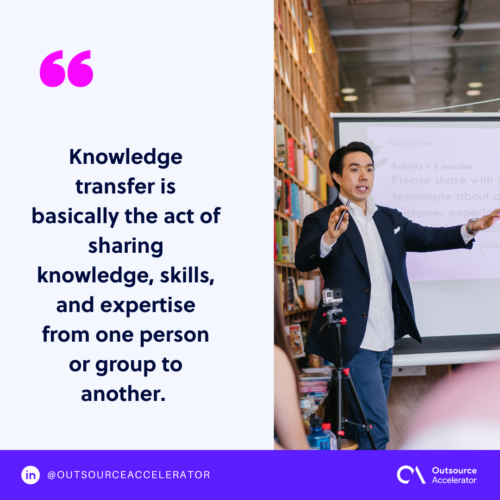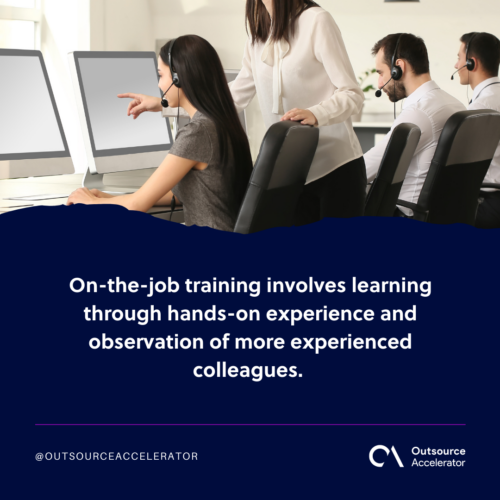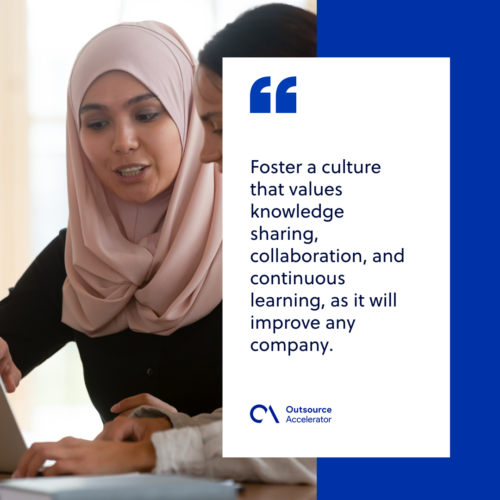Knowledge transfer: Defining the process and how to use it effectively

Nowadays, the knowledge transfer process is crucial in ensuring the smooth flow of information and expertise within organizations.
Effectively transferring knowledge from experienced individuals to others lets companies foster innovation and increase productivity. They can also develop a skilled and engaged workforce needed in today’s dynamic business landscape.
In this article, we’ll explore the concept of knowledge transfer, its advantages and disadvantages, and how organizations can implement effective knowledge transfer programs.
Defining knowledge transfer
Knowledge transfer is basically the act of sharing knowledge, skills, and expertise from one person or group to another.
It is a critical process for organizations that want to ensure that their employees have the resources and capabilities they need to perform their jobs effectively.
Knowledge transfer vs. Traditional training
So how does knowledge transfer differ from traditional training methods? While traditional training programs are often structured and formalized, knowledge transfer is a more informal and interactive process.
Knowledge transfer is a broader, more holistic approach, while traditional training focuses on imparting specific skills and information. Moreover, knowledge transfer involves the collaboration between the person or group sharing knowledge and those receiving it.

8 types of knowledge transfer
The dissemination of information through the knowledge transfer approach can take many forms, including:
1. Mentorship
Pairing experienced employees with less experienced individuals fosters one-on-one knowledge transfer. Mentors provide guidance and support and share their expertise to help mentees develop their skills and knowledge.
2. Coaching
Coaching involves a one-on-one or small group interaction where a more experienced individual, known as the coach, gives guidance, feedback, and support to the learner.
This is a personalized and interactive form of knowledge transfer that focuses on individual growth, development, and skill enhancement.
3. Training
Formal training is a systematic approach to knowledge transfer that aims to impart specific skills or knowledge to individuals or groups. It typically involves a trainer who delivers content through various methods, such as:
- Lectures
- Demonstrations
- Hands-on exercises
- Simulations
This method can take place in a classroom setting, virtually, or through e-learning platforms.
Training provides a structured and efficient way to transfer explicit knowledge, enabling learners to acquire and apply new competencies in practical situations.
4. Mastery training
Mastery training goes beyond traditional training methods and focuses on developing expertise and mastery in a particular domain or skill set.
It involves intensive and immersive learning experiences that allow individuals to delve deeply into a subject matter. This helps them acquire advanced knowledge and hone their skills exceptionally.
On top of that, mastery training often includes practical application, real-world problem-solving, and mentorship from experts in the field. It is designed to help individuals become masters in their respective areas of specialization.
5. On-the-job training
On-the-job training involves learning through hands-on experience and observation of more experienced colleagues. It allows individuals to acquire tacit knowledge by directly engaging in real-world situations.
6. Presentations
Presentations are where information, concepts, or ideas are shared with an audience. They can be formal presentations, seminars, workshops, or conferences.
It typically involves a presenter who delivers content using visual aids, such as slides or multimedia, to communicate key messages effectively.
Presentations are effectively used to share knowledge with a large group of people simultaneously. It then provides an opportunity for information dissemination, sharing of best practices, and inspiring new insights and ideas.
7. Documentation
Creating and maintaining documentation, manuals, and knowledge repositories ensure that knowledge is captured and accessible to others within the organization.
This type of knowledge transfer facilitates self-learning and reduces dependency on specific individuals.
8. Redeployment
Redeployment refers to transferring knowledge and skills from one individual or department to another within an organization. It occurs when an employee moves to a different role, team, or location, bringing their knowledge, expertise, and experiences with them.
Redeployment allows companies to leverage their staff’s existing knowledge and capabilities and ensure a smooth knowledge transition.
This approach includes job rotations, cross-functional projects, or knowledge-sharing sessions where knowledge and skills are passed on to others who will assume a person or group’s previous responsibilities.

Advantages of knowledge transfer
The implementation of knowledge transfer processes can generate the following benefits:
- Preservation of expertise – By transferring knowledge from experienced employees to others, organizations can preserve critical expertise that might otherwise be lost due to retirement or turnover.
- Accelerated learning – Knowledge transfer allows individuals to learn from the experiences of others, enabling them to acquire new skills and knowledge faster.
- Improved problem-solving – The transfer of tacit knowledge through knowledge transfer programs enhances individuals’ problem-solving abilities by providing them with real-life examples and insights.
- Enhanced collaboration and innovation – Knowledge transfer promotes collaboration and the sharing of ideas, leading to increased innovation within companies.
- Improved employee engagement – Knowledge transfer can help employees feel more engaged in their work, as they are learning new skills and taking on new challenges.
Disadvantages of knowledge transfer
While knowledge transfer presents ample advantages, it also has a set of drawbacks:
- Time and resource constraints – Implementing effective knowledge transfer programs requires time, resources, and commitment from the knowledge providers and recipients.
- Resistance to change – Some individuals may resist sharing their knowledge, fearing that it might diminish their value within the organization or that others may surpass them in skills and expertise. On the other hand, some may be reluctant to put in the time and effort to learn new things.
- Lack of structure – Tacit knowledge can be difficult to formalize and transfer. This can make it challenging to consistently and accurately apply the process.
Simple outline of the knowledge transfer process
The steps can vary depending on the type of knowledge transfer process you wish to implement.
Here’s a basic knowledge transfer outline you can follow:
- Identify the knowledge or skills that need to be transferred.
- Select the individuals or groups who need to receive the knowledge or skills.
- Determine the best method for transferring knowledge or skills.
- Implement the knowledge transfer process.
- Evaluate the effectiveness of the knowledge transfer process.
How to implement knowledge transfer programs
After comprehensively discussing the concept of knowledge transfer and everything that relates to it, it’s time to talk about implementing this process.
Here are ways you can successfully carry out knowledge transfer:
Assess organizational knowledge needs
Identify the critical knowledge areas and skills that must be transferred to address organizational goals and challenges.
This includes determining strategic objectives, conducting a skills gap analysis, considering future needs, and analyzing performance data.
Design knowledge transfer initiatives
Develop tailored programs and initiatives based on the identified knowledge needs. Consider the organization’s culture, resources, and preferences of knowledge providers and recipients.
In developing customized programs, consider the learning objectives, appropriate methods and channels, leveraging technology, provision of ongoing support, and evaluation.
Create a supportive environment
Foster a culture that values knowledge sharing, collaboration, and continuous learning, as it will improve any company.
One idea that helps cultivate a supportive company culture is to provide incentives and recognition for employees who actively participate in knowledge transfer activities.

Facilitate communication and collaboration
Establish channels and platforms for knowledge sharing, such as internal social networks, online forums, or regular team meetings.
Encouraging open communication permits collaboration between individuals to promote effective knowledge transfer.
Evaluate and refine
Lastly, regularly evaluate the effectiveness of knowledge transfer programs and gather feedback from participants. Use the insights gained to refine and improve future initiatives.







 Independent
Independent




